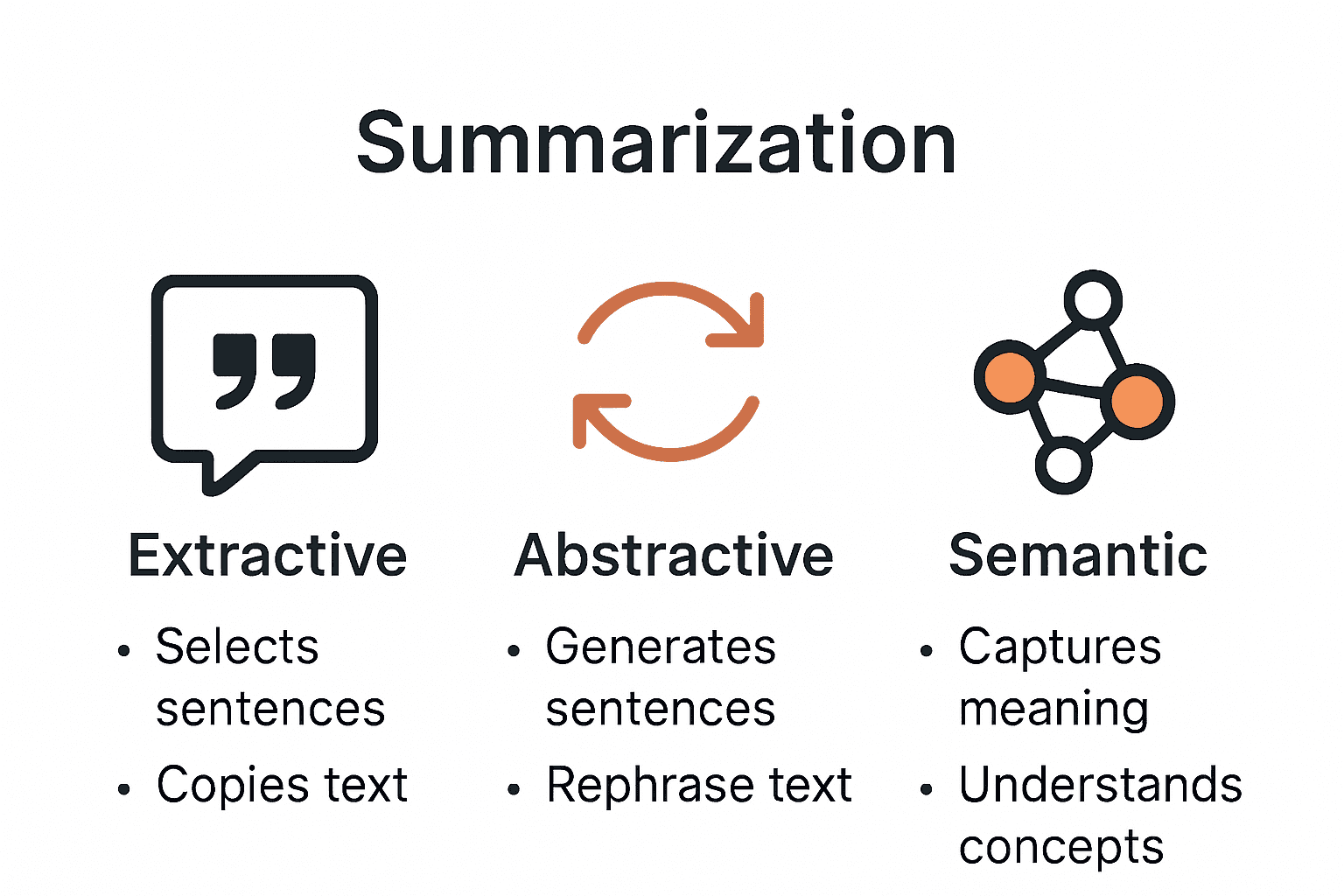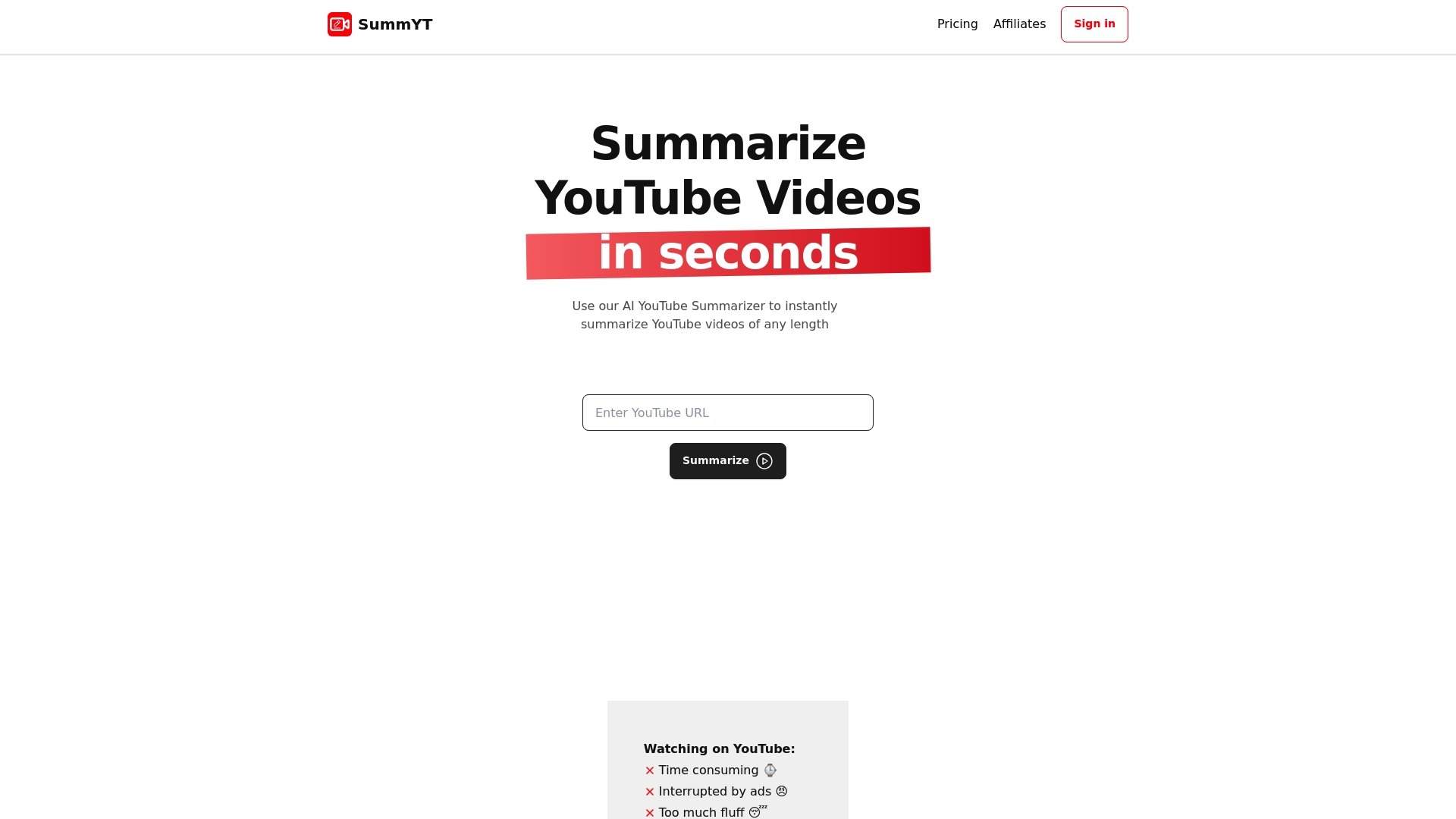What Is Summary Generation? Complete Guide Explained

Did you know that over 80 percent of digital content is never fully read or watched? As information piles up, many people struggle to keep up with research, news, or documentation. Summary generation uses artificial intelligence to distill hours of reading or viewing into clear, essential insights. This technology is changing how professionals and students handle dense materials by making complex topics easier to grasp in less time.
Table of Contents
- Summary Generation Defined And Core Concepts
- Types Of Summary Generation Methods Explained
- How Ai-Powered Summary Generation Works
- Real-World Applications And Use Cases
- Benefits, Risks, And Common Pitfalls
Key Takeaways
| Point | Details |
|---|---|
| Summary Generation | Utilizes AI algorithms to condense extensive content into concise formats, enhancing comprehension and information transfer. |
| Methods of Summarization | Key methods include extractive, abstractive, and semantic summarization, each serving different practical applications in information processing. |
| Real-World Applications | Summary generation is instrumental across various sectors including academia, legal, and healthcare for efficiently synthesizing large amounts of information. |
| Challenges and Risks | Issues like context loss, semantic distortion, and bias may affect the effectiveness of AI-generated summaries and require careful management. |
Summary Generation Defined and Core Concepts
Summary generation is a computational process that uses artificial intelligence algorithms to automatically condense large volumes of text, video, or audio content into concise, digestible representations. Automatic summarization transforms complex information into shorter formats that capture the essential meaning and key insights, enabling faster comprehension and knowledge transfer.
According to Wikipedia’s research on automatic summarization, these AI-powered techniques are designed to create subsets of content that represent the most important or relevant information within the original material. The core objective is to preserve critical context while dramatically reducing reading or viewing time.
The primary methods of summary generation include:
Here’s a comparison of common summary generation methods:
| Method | Key Approach | Output Style | Typical Use Cases |
|---|---|---|---|
| Extractive | Selects original text | Verbatim sentences | News overviews Legal reviews |
| Abstractive | Generates new text | Rewritten, paraphrased | Executive summaries Report briefs |
| Semantic | Analyzes meaning | Concepts & relationships | Research synthesis Knowledge graphs |
- Extractive Summarization: Identifies and pulls the most significant sentences or segments directly from the original content
- Abstractive Summarization: Generates entirely new text that captures the core meaning, often using advanced natural language processing techniques
- Semantic Summarization: Understands and distills the underlying concepts and relationships within the content
By leveraging sophisticated machine learning models, summary generation tools help professionals, students, and researchers quickly extract valuable insights from extensive documents, lectures, videos, and other media without sacrificing comprehension or depth.

Types of Summary Generation Methods Explained
Automatic summarization encompasses two fundamental approaches that transform complex content into concise representations. According to Wikipedia’s research on automatic summarization, these methods are distinguished by their unique techniques for condensing information.
Extractive Summarization is the most straightforward method, which directly identifies and extracts the most significant sentences or segments from the original content. This approach works by ranking sentences based on their importance, using techniques like statistical scoring, keyword frequency, and semantic analysis to determine which parts best represent the overall meaning.
Abstractive Summarization represents a more advanced technique that goes beyond simple extraction. Instead of pulling existing text, this method generates entirely new phrases and sentences that capture the core meaning of the original content. Powered by sophisticated natural language processing and machine learning algorithms, abstractive summarization can:

- Rewrite and rephrase content
- Create more concise and coherent summaries
- Understand contextual nuances beyond literal text
For professionals seeking to understand these methods in more depth, our 7 Types of Content Summaries guide offers comprehensive insights into the evolving landscape of summary generation technologies. Whether you’re a researcher, student, or content creator, understanding these methods can dramatically improve how you process and communicate information.
How AI-Powered Summary Generation Works
Artificial intelligence transforms the complex task of summarization through sophisticated neural network algorithms that break down and analyze content with remarkable precision. Research from arXiv reveals a novel “divide-and-conquer” approach that leverages the inherent discourse structure of documents to generate more accurate summaries.
The AI summarization process typically involves multiple sophisticated stages. First, the machine learning model preprocesses the input content, tokenizing text and identifying key linguistic structures. Then, advanced natural language processing algorithms analyze semantic relationships, extracting critical information by understanding context, importance, and interconnectedness of ideas.
Key computational techniques in AI-powered summary generation include:
- Semantic Ranking: Algorithms that score sentences based on their contextual significance
- Neural Network Processing: Deep learning models that understand nuanced language patterns
- Contextual Analysis: Techniques that interpret meaning beyond literal word-for-word translation
- Ensemble Learning: Combining multiple summarization approaches to improve accuracy
Understanding the advantages of AI summaries can help professionals appreciate how these advanced technologies are revolutionizing information consumption. By breaking down complex documents into digestible insights, AI-powered summary generation is transforming how we process and understand vast amounts of information across various domains.
Real-World Applications and Use Cases
Summary generation has rapidly evolved from a niche technological concept to a critical tool across multiple professional domains. According to Wikipedia’s research on automatic summarization, these technologies are transforming how organizations process and understand vast amounts of information across various sectors.
Multi-document summarization represents a particularly powerful application, enabling professionals to quickly synthesize insights from multiple sources. As Wikipedia explains, this technique allows users to rapidly familiarize themselves with complex information clusters by extracting key details from numerous related documents. This approach is especially valuable in fields like research, journalism, legal analysis, and competitive intelligence.
Practical applications of summary generation span diverse industries:
- Academic Research: Condensing multiple scholarly papers and research reports
- Legal Departments: Quickly reviewing lengthy contracts and legal documents
- Business Intelligence: Summarizing market reports, financial statements, and competitive analyses
- News and Media: Creating rapid overviews of breaking news and complex stories
- Healthcare: Synthesizing medical research papers and patient records
For professionals seeking to understand the breadth of these technologies, our 8 Examples of AI Summarization Tools guide offers comprehensive insights into how different industries are leveraging summary generation to enhance productivity and decision-making.
Benefits, Risks, and Common Pitfalls
Automatic summarization offers tremendous potential, but like any advanced technology, it comes with both significant advantages and inherent challenges. According to Wikipedia’s research on automatic summarization, these tools can dramatically simplify information search by pointing users directly to the most relevant source documents.
The primary benefits include dramatically reduced research time, enhanced information accessibility, and the ability to quickly extract core insights from complex materials. However, critical challenges persist. Wikipedia highlights that maintaining summary coherence, ensuring informativeness, and avoiding semantic redundancy remain significant technical hurdles for AI-powered summarization technologies.
Key risks and potential pitfalls include:
- Context Loss: AI summaries might miss nuanced contextual details
- Semantic Distortion: Potential misrepresentation of original content meaning
- Information Noise: Generating summaries that introduce unnecessary complexity
- Bias Amplification: Potential inheritance of underlying data or algorithmic biases
- Accuracy Limitations: Inconsistent performance across different content types
Understanding the advantages of AI summaries can help professionals develop more realistic expectations and implement these tools more effectively. The key is recognizing that summary generation is a powerful assistive technology, not a perfect replacement for comprehensive human analysis.
Unlock Faster Learning with AI-Powered Summary Generation
The challenge of processing lengthy videos and dense information is real, especially when you need quick comprehension without losing key insights. This article explains how summary generation condenses complex content by using advanced techniques like extractive and abstractive summarization. If you find yourself overwhelmed by long lectures, webinars, or tutorials, you are not alone. Many learners and professionals struggle to balance time and information depth, aiming to get to the core meaning efficiently.
With SummYT, you no longer have to sacrifice hours watching videos to grasp the essential points. Our AI-driven platform automatically generates clear, concise summaries from any YouTube video to help you save precious time and boost productivity. Designed for students, professionals, and lifelong learners, SummYT turns detailed content into digestible insights, eliminating fluff and distractions so you can focus on what truly matters.
Ready to transform the way you learn and consume information?

Explore the power of AI summarization now with SummYT at summyt.app. Discover how our unlimited summaries and user-friendly tools optimize your video learning experience. Don’t wait to unlock the full benefits of quick content comprehension and make overwhelming video libraries manageable today.
Frequently Asked Questions
What is summary generation?
Summary generation is a computational process that uses AI algorithms to condense large volumes of text, video, or audio content into concise representations, allowing for faster comprehension and knowledge transfer.
What are the main methods of summary generation?
The primary methods of summary generation are extractive summarization, which selects original text, abstractive summarization, which generates new text, and semantic summarization, which analyzes underlying concepts and relationships within the content.
What are some real-world applications of summary generation?
Summary generation is used in various fields including academic research, legal documentation, business intelligence, news media, and healthcare to condense complex information and enhance productivity.
What are the potential challenges of using AI-powered summarization?
Key challenges include the risk of context loss, semantic distortion, information noise, bias amplification, and accuracy limitations, which may affect how well the summaries represent the original content.




